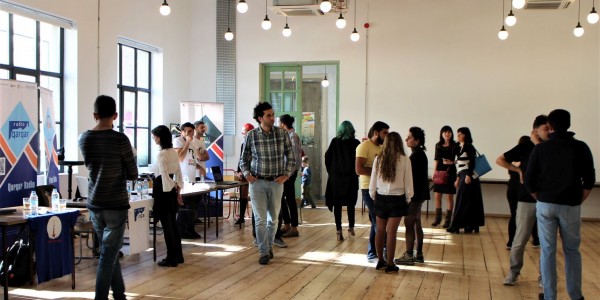Innovation on a Shoestring: Lessons from microwav.fm

“When we launched microwav.fm, everyone asked us, ‘Why radio? Why not video?’,” says Veronika Divisova, Sourcefabric’s head of strategic partnerships. She has been managing the project since it started in 2014. “But we were focused on groups for whom quality video would not be possible. Radio is much more accessible.”
Most of the microwav.fm participants had no prior journalism experience. Others lacked basic equipment. “We had no laptops, even no headphones,” recalls Ruzanna Harutyunyan of Women’s Voice Radio in Yerevan.
Thanks to funding provided by the Swedish international Development Agency (SIDA), and support from our partners at the Imagine Center for Conflict Transformation in Armenia and the Open Society Foundation in Georgia, we were able to provide the equipment and training to get these radio stations online with Airtime Pro.
Today there are about 20 stations on the microwav.fm network, broadcasting from Armenia, Azerbaijan and Georgia, as well as conflict zones in the South Caucasus such as Abkhazia and Nagorno-Karabakh.
With the project now coming to a close, participants gathered at two conferences in Yerevan, Armenia and Tbilisi, Georgia in early October to share experiences and ideas for sustaining their operations in the future. One common thread among them all has been the use of radio to bridge the worlds of old and new media, just as the microwav.fm network itself has built relationships across borders in a troubled region.
Arsen Kharatyan, Aliq Media
Aliq Media, a Tbilisi-based station that produces news in Armenian for the local Armenian population in Georgia, has made the leap to FM broadcasting with a commercial radio partner. Arsen Kharatyan, founder and editor-in-chief of Aliq Media, says “Our FM broadcasts are three times a day, at 3:00, 5:00 and 9:00 pm.” To expand that listenership, Aliq is planning to distribute analog radios to members of their target audience who are not connected to the digital world. “They are farmers out in the fields,” explains Kharatyan.
Ruzanna Harutyunyan and Vera Nurijanyan, Women’s Voice Radio
Serving a group of listeners with information that addresses their specific interests and concerns has been key for other microwav.fm stations too. Women’s Voice Radio offers programs on everything from women’s history to women’s health, along with updates on news such as a proposed law on domestic violence in Armenia. Meanwhile, the connection that Ruzanna Harutyunyan and her team made with the local Women’s Resource Center in Yerevan has provided Women’s Voice Radio with a stable source of support, as well as a physical base of operations. Both of those elements have been important in building a foundation for the future. “I have a lot of plans for projects that will raise awareness about issues affecting women who live outside the capital, especially in border and conflict zones,” says Harutyunyan.
Thinking broadly while still staying focused in a chosen medium exemplifies the approach of Caucasus Rock Station (CRS), a music-focused broadcaster based in Tbilisi.
Tengo Gualli, CRS
“We want to promote peace through rock music in all three countries [Georgia, Azerbaijan and Armenia],” says Tengo Gualli of CRS. Adds his co-founder Sandro Gvindadze, “We see more and more the need for a platform for musicians and their fan base that covers the whole region.” One of their long-term ideas is to even create a new indie rock festival in the South Caucasus.
As CRS and the other microwav.fm stations evolve and grow, Airtime Pro and our other tools will continue to support fresh thinking.
